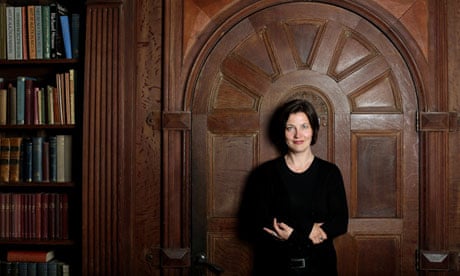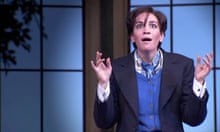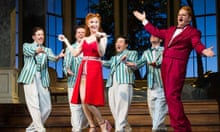Richard Strauss's gorgeously beguiling Ariadne auf Naxos is usually presented as a piece of genteel aristocratic entertainment. Its first half is a comedy of upper-class manners, in which "the richest man in Vienna" commissions some operatic works for a little after-dinner amusement; and the second gives him what he ordered, via a sumptuous vision of the lovelorn Ariadne on her lonesome island.
This opera within an opera, which makes the very theatre you're sitting in part of the drama, is not a piece in which you'd expect to find raw emotions or social commentary. Or, for that matter, bombs raining down on the set. But director Katharina Thoma's production, the opening attraction of this year's Glyndebourne festival, has all that and more. Her vision is an attempt to get to the big truths at the heart of Strauss's dazzling drama. This young German director, whose thought-provoking and vigorously musical productions of everything from Samuel Barber to Puccini have marked her out as one of her generation's most exciting talents, isn't just making her UK debut. This is also the first time she's tackled any of Strauss's operas.
The first half of Thoma's Ariadne is set unambiguously in an English country house in the 1940s, a place that bears a non-coincidental resemblance to Glyndebourne – which began life, after all, as a rich man's dream of operatic entertainment at his country pile. The cast, singing and speaking in the original German, hang up union flags and bunting, generating an atmosphere of country-house bonhomie.
But in the second half, Ariadne sure isn't on Naxos, or even a panto-style desert island in the middle of an aristo's drawing room. Instead, she's a patient in a second world war hospital, and Bacchus, her heroic saviour, is a Spitfire pilot. The reason is simple: Glyndebourne's own wartime history. "I was inspired by the way the house changed its function during the second world war," says Thoma. "It became a home for evacuated children. There are photos from that time of all the children's beds stuffed into the drawing room. That's what our set looks like."
Thoma consistently finds a deeper side to the airy confection of this 1916 drama, an approach much aided by this wartime setting. The character of Zerbinetta, part of a troupe of comedians, is conventionally played as a coquettish young woman, whose aria in the second half is an embodiment of the pleasures of sensuality and excess. But Thoma hears that showstopping number differently. "It's really a bit insane," she says. "It's superficially bright and easy, but actually all that coloratura expresses a deep longing. She is at least as heartbroken as Ariadne – it's just that she reacts in a different way. She is not well, not at all. She is obsessed by sex, by men. And during the war, when men and women came together and made love, it all happened very quickly, because they did not know if they would be alive tomorrow. It was a very explosive time – they were dancing on a volcano."
Thoma also takes the Composer through into the second half's opera as well, too. That's unusual: he only sings in the Prologue, and then almost always gets the operatic equivalent of an early bath. But his emotional journey through the entire work is one of the most important dimensions in Thoma's production. He appears at the start of the second half in the hospital with his score above his head, having cowered under falling bombs at the end of the Prologue. By the end, he has clearly changed. "We see him closing his book," says Thoma, "taking his suitcase, and going into a future where he will be able to create work of a very intense emotional nature due to this experience."
Thoma sees a connection between Strauss and the Composer. Does she think Strauss made that same journey from idealised love and rarefied thinking about art and music to a grounding in the real world? "Not really. For him, it was very difficult to accept reality and to let go of being an artist, to understand there are other things going on in the world – whether during the first world war, when he was revising Ariadne, or during the second. The bombing and destruction of the Munich opera house was more of a loss to him than the millions of dead."
While Strauss may have had a slightly tenuous grip on reality, Thoma makes his Ariadne auf Naxos a confrontation with it. But that's not to say she doubts his sincerity. "His emotions must have been true," she says. "Otherwise he couldn"t have written this astonishing music. I believe every single note."
Ariadne auf Naxos opens the Glyndebourne festival, Lewes, on Saturday. The production will be streamed live on the Guardian website on 4 June (theguardian.com/glyndebourne).
See also
* Thomas Allen on his role as the Music Master
* Kate Lindsey on her role as the Composer





Comments (…)
Sign in or create your Guardian account to join the discussion